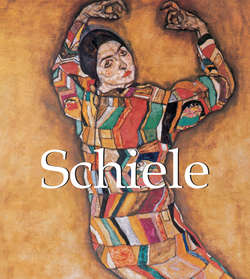Читать книгу Schiele - Ashley Bassie - Страница 4
На сайте Литреса книга снята с продажи.
Schiele’s Childhood
ОглавлениеIn modern industrial times, with the noise of racing steam engines and factories and the human masses working within in them, Egon Schiele was born in the railway station hall of Tulln, a small, lower Austrian town on the Danube on 12 June, 1890. After his older sisters Melanie (1886–1974) and Elvira (1883–1893), he was the third child of the railway director Adolf Eugen (1850–1905) and his wife Marie, (née Soukoup) (1862–1935).
Kneeling Girl in Orange-Red Dress
1910
Gouache, watercolour and black pencil on paper
44.6 × 31 cm
Leopold Museum, Vienna
The shadows of three male stillbirths were a precursor for the only boy, who, in his third year of life would lose his ten-year-old sister Elvira. The high infant mortality rate was the lot of former times, a fate which Schiele’s later work and his pictures of women would characterise. In 1900, he attended the grammar school in Krems. But he was a poor pupil, who constantly took refuge in his drawings, which his enraged father burned. In 1902, Schiele’s father sent his son to the regional grammar and upper secondary school in Klosterneuburg.
Seated Female Nude with Raised Right Arm (Gertrude Schiele)
1910
Gouache, watercolour and black pencil on paper
45 × 31,5 cm
Wien Museum, Vienna
The young Schiele had a difficult childhood marked by his father’s ill health. He suffered from syphilis, which, according to family chronicles, he is said to have contracted while on his honeymoon as a result of a visit to a bordello in Triest. His wife fled from the bedroom during the wedding night and the marriage was only consummated on the fourth day, on which he infected her also. Despair characterised Schiele’s father, who, retired early and sat at home dressed in his service uniform, in a state of mental confusion. In the summer of 1904, stricken by increasing paralysis, he tried to throw himself out of a window.
Nude Girl with Folded Arms (Gertrude Schiele)
1910
Watercolour and black pencil on paper, 48.8 × 28 cm
Albertina, Vienna
He finally died after a long period of suffering on New Year’s Day 1905. The father, who during a fit of insanity burned all his railroad stocks, left his wife and children destitute. An uncle, Leopold Czihaczek, chief inspector of the imperial and royal railway, assumed joint custody of the fifteen-year-old Egon, for whom he planned the traditional family role of railroad worker. During this time, young Schiele wore second-hand clothing handed down from his uncle and stiff white collars made from paper. It seems that Schiele had been very close to his father for he, too, had possessed a certain talent for drawing, had collected butterflies and minerals and was drawn to the natural world.
Self-Portrait Pulling Cheek
1910
Gouache, watercolour and pencil
44.3 × 30.5 cm
Albertina, Vienna
Years later, Schiele wrote to his sister: “I have, in fact, experienced a beautiful spiritual occurrence today, I was awake, yet spellbound by a ghost who presented himself to me in a dream before waking, so long as he spoke with me, I was rigid and speechless.” Unable to accept the death of his father, Schiele let him rise again in visions. He reported that his father had been with him and spoken to him at length. In contrast, distance and misunderstanding characterised his relationship with his mother who, living in dire financial straits, expected her son to support her; in return, the older sister would work for the railroad.
Reclining Male Nude with Yellow Pillow
1910
Gouache, watercolour and black pencil on paper
31.1 × 45.4 cm
Private collection
However, Schiele, who had been pampered by women during childhood, claimed to be “an eternal child”. By a stroke of fate, the painter Karl Ludwig Strauch (1875–1959), instructed the gifted youth in draftsmanship; the artist Max Kahrer of Klosterneuburg looked after the boy as well. In 1906, at the age of only sixteen, Schiele passed the entrance examination for the general art class at the Academy of Visual Arts in Vienna on his first attempt. Even the strict uncle, in whose household Schiele now took his midday meals, sent a telegram to Schiele’s mother: “Passed.”
Seated Male Nude (Self-Portrait)
1910
Oil and gouache, 152.5 × 150 cm
Leopold Museum, Vienna
His sister Gertrude (1894–1981), called “Gerti”, four years his junior, was a compliant subject for him. In a watercolour, Gerti reclines backwards, still fully clothed with black stockings and shoes, and lifts the black hem of her dress from under which the red orifice of her body gapes. Schiele draws no bed, no chair, only the provocative gesture of his sister’s body offering itself (Reclining Girl in a Dark Blue Dress, 1910).
Reclining Girl in a Dark Blue Dress
1910
Gouache, watercolour and pencil with white highlights
45 × 31.3 cm
Stefan T. Edlis Collection
Incestuous fantasies? At the same time as Sigmund Freud discovered that self-discovery occurs by way of erotic experiences, and the urge to look emerges as a spontaneous sexual expression within the child, young Egon recorded confrontations with the opposite sex on paper. He incorporated erotic games of discovery and showed an unabashed interest in the genitalia of his model into his nude studies – the forbidden gaze, searching for the opened female vagina beneath the rustling of the skirt hem and white lace. Gerti with her freckled skin, the green eyes and red hair is the prototype of all the later women and models of Schiele.
Grimacing Man (Self-Portrait)
1910
Charcoal, watercolour and gouache on paper
44 × 27.8 cm
Leopold Museum, Vienna
